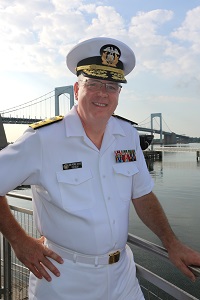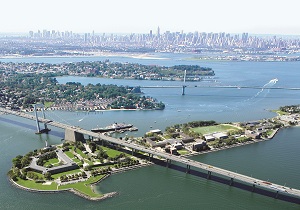SUNY Maritime has a Man on a Mission
As the new President of the State University of New York (SUNY) Maritime College, Rear Admiral Michael Alfultis finds himself asking a very challenging question: Will SUNY Maritime be able to continue meeting the U.S. demand for licensed mariners?
 His college, like the other five U.S. state maritime academies, has a very old vessel on which its students gain their sea time and training necessary to earn their merchant marine license and begin their careers in the maritime industry. SUNY’s Training Ship Empire State VI is 53-years-old, while the average age of the U.S. state maritime academies training vessels is 35.
His college, like the other five U.S. state maritime academies, has a very old vessel on which its students gain their sea time and training necessary to earn their merchant marine license and begin their careers in the maritime industry. SUNY’s Training Ship Empire State VI is 53-years-old, while the average age of the U.S. state maritime academies training vessels is 35.
“We have to replace these aging ships. If we don’t, we cannot produce the licensed mariners that this country needs. We need licensed mariners for national security, to maintain defense readiness and to support our growing maritime industry. We are also at a critical time with an aging workforce in the maritime industry.”
In the age of diesel engines, SUNY’s ship has a steam driven propulsion system. It has significant habitability issues and does not meet modern environmental standards for emissions to air or to sea.
The vessels used by the State Maritime Academies all are converted tankers or bulk carriers, from the U.S. inventory of ships in reserve. “We don’t have as many vessels left in reserve any more. A lot of them have been scrapped. Of those available, the conversion to a training vessel is costly, and the return of investment relative to construction of a new vessel is less,” says Alfultis.
Instead, he is supporting the U.S. Maritime Administration’s proposal for construction of five new-build national security, multi-mission vessels. “The construction of these ships is a national imperative for the U.S., and these ships will have the ability to support the nation’s humanitarian and disaster relief efforts. In both Hurricane Sandy and Hurricane Katrina, our ship and another training ship were used to provide housing and support services for 1000 federal response workers. So these new ships could be designed to fulfill two purposes: to train future licensed mariners at sea; and support relief efforts in times of national need. We need licensed mariners. We need these ships.”
Alfultis is new to the college this year, after serving as Director of the University of Connecticut’s Avery Point Campus. Prior to his time at the University of Connecticut, Alfultis served 28 years with the U.S. Coast Guard, retiring in 2010 as a Captain. Twenty-one of those years he served as a faculty member at the Coast Guard Academy. With more than two decades service as a faculty member at the Coast Guard Academy, he knows well the role that innovative teaching platforms such as simulators and training ships can play in higher education.
 With the management change, course delivery is under review, and Alfultis sees electronic delivery as playing a greater role in reaching out both to the younger generation and to more experienced mariners continuing their lifelong education. The college currently has two post-graduate programs, and is increasing the range of refresher and specialized programs offered through its Department of Professional Education and Training.
With the management change, course delivery is under review, and Alfultis sees electronic delivery as playing a greater role in reaching out both to the younger generation and to more experienced mariners continuing their lifelong education. The college currently has two post-graduate programs, and is increasing the range of refresher and specialized programs offered through its Department of Professional Education and Training.
One of the challenges the school faces is the constantly growing regulatory burden placed on mariners from IMO and U.S. regulators. With licensed mariners in increasing demand, Alfultis and his team must stay ahead of the game, “Are we going to be able to produce enough licensed mariners? Demand is going up, but at the same time, the regulatory overhead is making it more difficult for people to get their license.”
2014 has been a big year for infrastructure at SUNY Maritime College with the construction of a new $36 million academic building, and the installation of two new radar and electronic navigation simulators and a new tug and barge simulator. On the way is a new full mission engineroom simulator and a liquid cargo handling system simulator.
Alfultis sees a promising future for SUNY Maritime with all the pieces falling into place – infrastructure improvements, strong enrollments and increasing quality of incoming students, curriculum changes, and strong industry demand for its graduates. However, the one essential piece required in order for SUNY Maritime to continue to meet the demand for licensed mariners remains a suitable replacement vessel for training 1,000 cadets each year. He knows that at a time when the U.S. federal budget is tight this is a challenge but as he says, “What is the option? We need licensed mariners.”
The opinions expressed herein are the author's and not necessarily those of The Maritime Executive.
